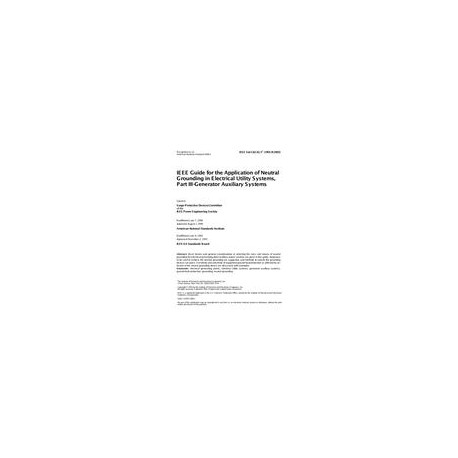Cart
0
Product
Products
(empty)
No products
To be determined
Shipping
$0.00
Total
Product successfully added to your shopping cart
Quantity
Total
There are 0 items in your cart.
There is 1 item in your cart.
Total products
Total shipping
To be determined
Total
New
Reduced price!
 View larger
View larger
 View larger
View larger
IEEE C62.92.3-1993
M00138347
New product
IEEE C62.92.3-1993 IEEE Guide for the Application of Neutral Grounding in Electrical Utility Systems, Part III - Generator Auxiliary Systems
standard by IEEE, 06/03/1994
Full Description
Scope
This guide summarizes the general considerations in grounding of generating station auxiliary power systems anddiscusses the factors to be considered in selecting between the appropriate grounding classes and in specifyingequipment ratings. This guide applies to both medium-voltage and low-voltage auxiliary power systems. Groundingand bonding to achieve practical safeguarding of persons is fulfillled by electrically connecting equipment frames andenclosures and interconnecting wiring raceways to the station grounding network (see IEEE Std 142-1991 1), asrequired by ANSI C2-1993. References to safety in this guide mean freedom from equipment damage. The emphasisis on reliability and availability of auxiliary system service achieved through control of ground-fault currents andtransient overvoltages.This guide is specifically written for electrical utility systems and does not recognize the neutral grounding requirements for dispersed storage and generation. These requirements must recognize the restrictions imposed by the specific network to which the dispersed storage or generation is connected. Neutral grounding of dispersed storage and generation needs to be coordinated with the electrical utility system.Purpose
The purpose of this guide is to present some basic considerations for the selection of neutral grounding parameters that will provide for the control of ground-fault currents and overvoltage on auxiliary systems of electrical utility threephase generators.Abstract
New IEEE Standard - Superseded.Basic factors and general considerations in selecting the class and means of neutral grounding for electrical generating plant auxiliary power systems are given in this guide. Apparatus to be used to achieve the desired grounding are suggested, and methods to specify the grounding devices are given. Sensitivity and selectivity of equipment ground-fault protection as affected by selection of the neutral grounding device are discussed, with examples.In stock

